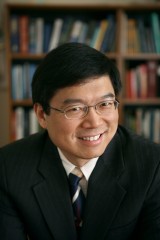

Washington University in St. Louis
Lihong Wang, PhD
In the Jan. 5 issue of Nature Communications, Wang, the Gene K. Beare Professor of Biomedical Engineering at Washington University in St. Louis, reveals for the first time a new technique that focuses diffuse light inside a dynamic scattering medium containing living tissue. In addition, they have improved the speed of optical focusing deep inside tissue by two orders of magnitude. This improvement in speed is an important step toward noninvasive optical imaging in deep tissue and photodynamic therapy.
In the new research, Wang and his team have built on a technique they developed in 2010 to improve the focusing speed of time-reversed ultrasonically encoded (TRUE) optical focusing for applications in living tissue. To focus light, the engineers use a virtual internal guide star at the targeted location. By detecting the wavefront of light emitted from the guide star, they can determine an optimum phase pattern that allows scattered light moving along different paths to focus at the targeted location.
When light is shined into living biological tissue, breathing and blood flow changes the optical interference, or speckle pattern, which can cause previous methods to focus diffuse light inside scattering media to fail. Scientists have to act quickly to get a clear image.
The new TRUE technology combines two techniques: focused ultrasonic modulation and optical phase conjugation. Researchers use a type of mirror to record then time-reverse the ultrasound-modulated light emitted from the ultrasonic focus to achieve the best focus. Previously, technology limited the speed of TRUE focusing to no more than 1 Hz.
To overcome this obstacle, the team used a fast-responding photorefractive crystal that is sensitive to light at the 790-nanometer wavelength, making it suitable to focus light deep into biological tissue. The new TRUE technology is able to focus light inside a dynamic medium with a speckle correlation time as short as 5.6 milliseconds. The improved speed allowed Wang to achieve the first optical focusing of diffuse light inside a scattering medium containing living biological tissue.
Going forward, the team plans to implement the system in a reflection configuration, where light is shined and detected on the same side of the tissue.
The School of Engineering & Applied Science at Washington University in St. Louis focuses intellectual efforts through a new convergence paradigm and builds on strengths, particularly as applied to medicine and health, energy and environment, entrepreneurship and security. With 91 tenured/tenure-track and 40 additional full-time faculty, 1,300 undergraduate students, more than 900 graduate students and more than 23,000 alumni, we are working to leverage our partnerships with academic and industry partners — across disciplines and across the world — to contribute to solving the greatest global challenges of the 21st century.
Liu Y, Lai P, Ma C, Xu X, Grabar A, Wang LV. Optical focusing deep inside dynamic scattering media with near-infrared time-reversed ultrasonically encoded (TRUE) light. Nature Communications, online Jan. 5, 2015. DOI: 10.1038/ncomms6904.
Funding from the National Institutes of Health (DP1 EB016986 and R01 CA186567) supported this research.
Contact Information
Julie Flory
Asst. Vice Chancellor for Campus Communications
Phone: 314-935-5408
julie.flory@wustl.edu












